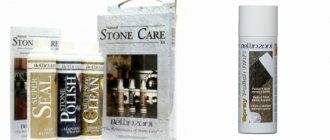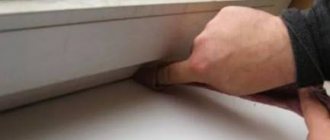Removing old coating - how to ensure a surface suitable for restoration
Updating furniture begins with removing old varnish. Don’t even try to paint or apply varnish over paintwork – you’ll just waste time, effort and materials. But, before you start cleaning the surface, first remove all existing fittings - handles, locks, legs, etc.
As for the old paintwork, you can remove it in several ways:
- mechanical;
- chemical;
- thermal.
To remove varnish mechanically, you will need sandpaper with a medium abrasive. You should not use something that is too rough, as it will leave deep scratches on the surface of the product. The disadvantage of this method is that it requires a lot of time and effort. Therefore, it makes sense to use sandpaper only for finishing the surface or processing hard-to-reach areas.
You can speed up the work using a grinder with an abrasive attachment. But it is convenient to process large and flat areas. If you need to restore a chair, using a sander is not very convenient. In this case, it is better to use a chemical remover. This is a special paste-like product that is designed to remove any paint and varnish coatings.
The remover should be applied using a brush, preferably with soft bristles. After applying it, it is necessary to cover the treated surface with plastic film and wait until the composition softens the coating. The time it takes for the paste to react with the varnish depends on the manufacturer and the thickness of the paint layer. More details about this are provided in the instructions on the packaging. After the coating has softened, you need to remove the paste along with the old varnish using a spatula or scraper.
You must work with the paste carefully, as it contains acid and is very toxic. It should be applied in a ventilated area, after wearing gloves.
If you are unable to completely clean the surface the first time, reapply the paste. Upon completion of this procedure, lightly “walk” over the surface of the product with a medium-abrasive sandpaper to get rid of chemical residues.
There is another way to remove old paint or varnish - using a hair dryer. This device allows you to heat the coating, as a result of which it softens and is easily removed with a spatula. The main thing is not to overheat the surface so that it does not ignite. Please note that this method is also quite toxic - when heated, the paint releases toxic substances, so you need to work in a ventilated area. After cleaning the surface, use sandpaper to get rid of any remaining varnish in the pores of the wood.
DIY furniture restoration
DIY furniture repair is sometimes simply necessary. No matter how high-quality our furniture is, it still loses its “marketable appearance” over time under the influence of physical stress and the influence of the environment (humidity, heat).
This is when a paradoxical situation is created: the furniture seems to be new, but it’s too early to change it, which means it’s time to repair the furniture at home.
Of course, it is better to fix complex damage professionally, in a woodworking workshop. But most of the problems are not caused by them, but by minor defects - abrasions, cracks, chips at the corners, damage to the paintwork.
Very often, even a minor scratch can ruin the appearance of the entire interior - which means that the skills of prompt furniture repair will not hurt you.
So, let's figure out how you can repair wooden furniture yourself.
Furniture repair is a fairly simple task that even a non-professional can do. There is almost no need for special skills for this, and if you know at least the basics
We fix minor defects
Here is a list of the most common injuries, as well as ways to solve them:
- The most common type of such defects is damage (crack, scratch or abrasion) to the paintwork. In order to restore minor damage to the varnish, wipe the surface of the product with a cloth swab dipped in a mixture of linseed oil and alcohol in a 1:1 ratio. After this, after waiting for the surface to dry completely, we polish it to a shine using a clean cloth.
If the varnished surface is damaged deeply enough (the deep layers of the varnish are affected), then we cover the damaged area with a layer of plain varnish, dry it and polish it with a cloth.
Most often, repairing old furniture with your own hands is done this way.
Note! If shellac varnish was used, then for polishing it is advisable to use a mixture of GOI paste with kerosene, or a mixture of linseed oil and alcohol. If the surface was coated with a nitro-varnish-based composition, then to achieve the best polishing effect, use a 1:1 mixture of alcohol and solvent.
- When we find stains on a varnished surface, we first determine their origin. If this fails (most often this is what happens), wipe the stain with a cloth swab dipped in gasoline. If necessary (for example, if after the gasoline has dried, a fragment of the stain remains on the furniture), repeat the operation after some time. After the polished surface is cleaned, wipe it with a cloth until it shines. We restore the polish that was damaged during stain removal by wiping the furniture with a mixture of denatured alcohol and linseed oil.
- If a stain from a hot object (kettle, pan or iron) has formed on a polished surface, remove it by wiping the damaged area with a swab dipped in alcohol, after which we restore the polish. If the damage is severe enough, such a stain can be removed by polishing with a mixture of drying oil and alcohol. After there are no traces of the stain left, be sure to wipe the surface with a swab dipped in pure alcohol, and then polish it with a cloth.
Surface restoration – putty, glue and sand
To truly update old polished furniture, rather than just repaint it, you need to get rid of all its defects, such as chips, cracks and crevices . To do this you will need the following materials:
- Putty (starting and finishing).
- Wood glue (you can use epoxy, which provides a more reliable connection).
- Degreaser.
Start by gluing the parts that need it. The surfaces to be glued must be cleaned with sandpaper and degreased. After gluing, the parts should be secured with clamps and left while the glue hardens.
Then you can start puttingty. This procedure is carried out in several steps:
- All narrow gaps and cracks must be widened so that they can be filled with putty.
- For deep defects such as chips and cracks, apply starting putty and wait until it hardens.
- Then it is necessary to clean the cured coating to remove any serious irregularities and apply a thin, even layer of finishing putty.
- Using the latter, you can also remove scratches and other minor defects on the surface of furniture.
- After the putty has hardened, it must be sanded with fine abrasive sandpaper.
After eliminating defects on the surface of the furniture, you need to sand it yourself with sandpaper or a sander to get rid of small scratches and roughness. Therefore, the abrasive grain should be minimal.
If you plan to use a clear coat, match the finishing putty to the color of the wood. You can paint wood fibers on the surface of the putty with brown paint.
Features of restoration of lacquered furniture
Scratches often appear on polished and varnished furniture. A rather fragile surface quickly loses its original appearance, becomes dull, darkens and swells in places, moving away from the surface. The appearance of such furniture is influenced by operating conditions, the quality of the varnish and the service life of the item.
There are three ways to restore the surface of lacquered furniture:
- Partially remove the varnish, touching only the affected area. Partial repairs do not take much time and are quite cheap. But partial replacement of varnish is visible visually - unsightly transitions form on the surface. Fresh varnish shines and has a mirror surface. This restoration method is suitable for eliminating defects on the inside or inconspicuous side.
- Replace the varnish on the entire surface of the furniture. To do this, you will need to completely remove the old coating and apply a new one. The work is painstaking, especially if the item is seriously damaged.
- Replace paintwork. The purpose of restoration is to completely change the design of an object. The varnish is removed, the surface is covered with paint, veneer or any other material.
If the furniture is old, the varnish has faded or is swollen, then it is not worth maintaining such a coating. It is necessary to completely replace the decorative layer to make the piece of furniture attractive and modern.
Applying clear varnish - how to achieve a glass effect
Finishing is the most creative stage of work on which the design of your furniture depends. Of course, when choosing the type of coating, you need to focus on the interior of the room in which the furniture will be used. But the field for creativity still remains wide. As an example, let's look at some of the most popular and spectacular decorative finishing options.
If your furniture is made of valuable wood, such as mahogany or oak, you don’t even have to think about choosing a finishing material. These breeds themselves look beautiful. Therefore, all that is required of you is to coat the product with transparent paint. For this, use a special furniture nitrocellulose varnish, which has increased hardness and smoothness. You can also use polyurethane, alkyd or acrylic varnish. The latter is good because it dries quickly and has no odor.
After applying the first layer of water-based varnish, the surface must be sanded with fine sandpaper. This is done in order to get rid of roughness that appears as a result of swelling of wood fibers.
You can apply the varnish using a regular brush or swab. The surface should be covered with it in several layers, always with interlayer drying. The more layers of varnish you apply, the “deeper” the coating will be, that is, the “glass effect” will appear .
Restoration of varnish coating
It is possible to restore the varnish coating in our workshop in several ways. They differ both in restoration technology and in restoration price. You can find out the price of restoring the varnish of a specific item by calling 8(495)364-93-23 via our email, or WhatsApp 8(985)364-93-23.
A gentle, traditional option for museum restoration is the regeneration of the worn-out varnish layer. It is used, as a rule, to restore old antique furniture that was once coated with reversible alcohol varnishes or polishes based on shellac or colloxylin. Such coatings were widely used until the 70s of the 20th century.
The second option for restoring the varnish coating is typical for repairing objects with a high degree of destruction, where the varnish has practically not been preserved. Complete removal of traces of old contaminated or destroyed coating with subsequent restoration. This radical option is used only if the restorer has sufficient qualifications to completely repeat the ancient technology of antique finishing.
Between these two methods, there are a lot of techniques that allow you to restore varnish using the best technology for a given item.
To eliminate minor scratches and light abrasions of modern furniture finished with polyurethane or polyester varnishes, it is possible to polish the surface with special polishing pastes.
Restoring the varnish coating of antique furniture is one of the most popular services that our workshop provides.
Over time, varnish layers undergo aging, which is mainly expressed in discoloration, yellowing and clouding. Many small cracks are visually perceived as clouding of the varnish layer or white spots. Natural aging of varnish is inevitable, but the most destructive effect on the varnish coating is caused by moisture and elevated temperature. The combination of these two factors is most clearly manifested in the white circles on the surface of countertops that are left by containers of hot water.
Artistically, varnish is designed to bring out the depth and richness of the color and texture of the wood.
The second important purpose of the restored varnish coating is the preservation of furniture. Its protective film protects wood from direct contact with air, with water vapor and various gases, dust and soot contained in it.
Restoring a varnish coating mainly comes down to the complete or partial replacement of damaged, whitened or darkened varnish.
In restoration, four processes for restoring the varnish coating are practiced: regeneration, thinning with further build-up, leveling and complete removal with subsequent restoration.
The first way to restore a varnish coating is regeneration, proposed in 1863 by Professor Pettenkofer. The essence of this method is that alcohol vapor, penetrating into the smallest cracks of the old varnish, softens it and transforms it into a single film, restoring its transparency.
This method of restoring varnish was originally developed for painting restoration. Currently, the Pettenkofer method has found wide application in furniture restoration.
Restoring the varnish coating with its complete removal first is highly undesirable. The surface of the furniture loses its original finish, but sometimes this is inevitable. The need to replace the old varnish is caused by a number of reasons: complete destruction of the original varnish layer, deep scratches and severe abrasions, the dilapidated state of the entire veneer with numerous cracks, losses, unsuccessful insertions of the previous restoration.
Surface tinting - turning pine into mahogany
The most common wooden furniture is made of pine and spruce. The texture of these rocks is very beautiful, but the color gives off a certain budget. The problem can be solved by tinting. To do this, you need to select a stain of a suitable color and treat the surface with it. It, unlike varnish, is not simply applied, but rubbed into the wood. Therefore, when working with it, you should make multiple circular or reciprocating movements with your brush over the same area.
After applying the stain, the product should be coated with varnish, which is applied according to the scheme described above. If desired, you can use glaze instead of stain and varnish. This paint coating is something between impregnation, varnish and paint. It gives the wood a certain shade, but does not hide the texture and provides gloss.
What tools and materials are needed?
To restore lacquered furniture, you should have the following tools at hand:
- Brushes, rollers. It is better to take several brushes of different widths. This is necessary for convenience when painting hard-to-reach places. A roller is useful for applying paint and varnish material on flat areas.
- Sanding sheets. Necessary for removing varnish and treating surfaces after removing paint and varnish material. Sandpaper makes the surface rough, which improves paint application and increases adhesion to wood.
- Wire brush. This is useful if you don’t have a grinding machine at hand to remove the decorative layer. Working with a metal brush is convenient, but the surface treatment time increases.
- Putty. Necessary material for furniture repair. Scratches and chips are filled with putty and the surface is leveled.
- Primer. Levels the surface, improves the adhesion of varnish and paint to the surface.
- Degreaser. Any will do, you can take regular acetone, which is also convenient for removing stains after finishing the staining.
- Varnish, paint, materials for decoration. The choice depends on the expected result - do you want a varnish or matte surface.
For DIY repairs, you can also prepare a hair dryer, a small spatula, a grinder, and a remover. But in most cases, the tools listed are sufficient to restore varnished items.
How to imitate wood - finishing with plywood or chipboard
Materials such as chipboard themselves have an unattractive appearance. In order to reliably imitate wood without much expense, furniture made from such materials can be decorated with wallpaper with a corresponding pattern. This method is good for finishing chests of drawers, tables, cabinets, cabinets and other large items. The finishing process is quite simple:
- Prime the product with acrylic varnish in two layers.
- Cut the wallpaper according to the size of the furniture.
- Glue the wallpaper with PVA glue.
After this, the surface must be varnished according to the standard scheme. But first you need to let the wallpaper dry. Note that trellises for finishing furniture can be used not only to resemble wood, but also with any other pattern. The choice depends solely on your wishes.
How to restore lacquered furniture?
Nowadays, lacquered furniture is in trend, because it has an attractive appearance and enhances the decoration of the room. However, such furniture has a disadvantage - it is prone to scratches. To avoid unnecessary expenses on a new interior element, you can try to restore an existing one.
- Nuances of recovery
- Methods for carrying out restoration measures Analysis of the degree of wear of lacquered furniture
- Products for restoring lacquered furniture
- Preparation:
Restoration services are currently provided by most furniture companies. You can restore interior items at home by following a number of guidelines.
Painting furniture – we finish it simply and practically
The simplest solution in terms of finishing is painting. For these purposes, you can use alkyd, alkyd-urethane or acrylic water-dispersion paint. To prevent furniture design from seeming too boring, paints of two or three colors are often combined. To ensure smooth transitions, simply apply masking tape. You can even make stencils for drawing.
Apply paint with a brush or roller. But the best effect can be achieved with a spray. If it is not possible to use a spray bottle, use spray paints.
To make the furniture look “branded”, be sure to apply several layers of varnish on top. The only thing is that it is desirable that it have the same base as the paint. The exception is water-dispersion varnish, which adheres well to any type of paint.
Craquelure effect - first we update, and then we age
If the interior is antique, an excellent solution would be to decorate the furniture with craquelure. This is cracked paint that reveals a layer of another paint that is different in color. To create this effect you will need a special craquelure transparent varnish and an acrylic primer.
The work is carried out in several steps:
- Cover the surface of the wood with several layers of acrylic primer, drying between layers.
- Apply any paint. This will be the base layer, that is, the one that is visible through the cracks. I must say that bronze shades and other “metallics” look especially beautiful.
- After the paint has dried, apply craquelure varnish.
- Wait until the varnish begins to dry (it should not be sticky), and apply a second layer of paint that is different in color from the first. Almost immediately it will begin to crack. If the layer is thick, the cracks will be large. If it is thin, the cracks will be thinner and shorter.
Upon completion of the work, the surface can be varnished. The only thing is that it is advisable to use matte varnish, because gloss and antiquity in this case are incompatible.
Metallic paints cannot be applied as a second coat, as they will not crack.
A few words about polishing - how to achieve a “mirror”
It is not always possible to apply varnish evenly and smoothly, especially for beginners. However, all flaws can be easily eliminated by grinding and polishing. To perform this operation you will need a grinder and two polishing wheels - hard and soft. In addition, you will need a polish with and without abrasive, plus “zero” sandpaper.
Work begins with grouting the surface with a “zero” finish. After removing the imperfections and making the coating matte, you can begin polishing. First, a hard wheel and abrasive paste are applied. After obtaining shine, you should move on to a non-abrasive paste and a soft wheel. The result should be a good gloss. Please note that during the polishing process it is extremely important not to overheat the surface, as this can ruin the varnish.
That's all we wanted to tell you about furniture restoration. Now all that remains is to install new fittings, which must match the design of the product, and you can start using it. As you can see, the work is not difficult, but very interesting, and anyone can cope with it.











